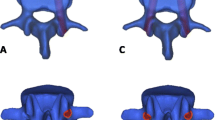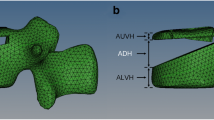Abstract
Adjacent vertebral fractures are common in patients with osteoporotic vertebral compression fractures (OVCFs) after kyphoplasty. This finite element study was to examine whether short segment pedicle screw fixation (PSF) with kyphoplasty may decrease the fracture risk of the treated and adjacent non-treated vertebrae after kyphoplasty for OVCFs. By simulating cement augmentation with or without short segment pedicle screw fixation (PSF), two tridimensional, anatomically detailed finite element models of the T10–L2 functional spinal junction were developed. The insertion of pedicle screws into the intact vertebra apparently decreased the stress distribution of the treated vertebra in vertical compression and other load situations. The stress distribution in the bone structures of the intact vertebra adjacent to the intact-screwed vertebra was much less than that in the one adjacent to the treated vertebra. The insertion of pedicle screws into the intact vertebra greatly decreased the maximum displacement of the cortical bones and cancellous bones of the vertebrae. Our results indicated that short segment PSF with kyphoplasty may decrease the fracture risk of the treated and adjacent non-treated vertebrae in the management of OVCFs.
Similar content being viewed by others
References
Hasserius R, Karlsson MK, Jonsson B, et al. Long-term morbidity and mortality after a clinically diagnosed vertebral fracture in the elderly—a 12-and 22-year follow-up of 257 patients. Calcif Tissue Int, 2005,76(4):235–242
Korovessis P, Repantis T, Miller LE, et al. Initial clinical experience with a novel vertebral augmentation system for treatment of symptomatic vertebral compression fractures: a case series of 26 consecutive patients. BMC Musculoskelet Disord, 2011,12:206
Majd ME, Farley S, Holt RT. Preliminary outcomes and efficacy of the first 360 consecutive kyphoplasties for the treatment of painful osteoporotic vertebral compression fractures. Spine J, 2005,5(3):244–255
Gerling MC, Eubanks JD, Patel R, et al. Cement augmentation of refractory osteoporotic vertebral compression fractures: survivorship analysis. Spine, 2011,36(19):e1266–E1269
Prather H, van Dillen L, Metzler JP, et al. Prospective measurement of function and pain in patients with non-neoplastic compression fractures treated with vertebroplasty. J Bone Joint Surg Am, 2006,88(2):334–341
Trout AT, Kallmes DF, Kaufmann TJ. New fractures after vertebroplasty: adjacent fractures occur significantly sooner. AJNR Am J Neuroradiol, 2006,27(1):217–223
Kim MJ, Lindsey DP, Hannibal M, et al. Vertebroplasty versus kyphoplasty: biomechanical behavior under repetitive loading conditions. Spine, 2006,31(18):2079–2084
Sun K, Liebschner MA. Biomechanics of prophylactic vertebral reinforcement. Spine, 2004,29(13):1428–1435
Voormolen MH, Lohle PN, Juttmann JR, et al. The risk of new osteoporotic vertebral compression fractures in the year after percutaneous vertebroplasty. J Vasc Interv Radiol, 2006,17(1):71–76
Uppin AA, Hirsch JA, Centenera LV, et al. Occurrence of new vertebral body fracture after percutaneous vertebroplasty in patients with osteoporosis. Radiology, 2003,226(1):119–124
Gu YT, Zhu DH, Liu HF, et al. Minimally invasive pedicle screw fixation combined with percutaneous vertebroplasty for preventing secondary fracture after vertebroplasty. J Orthop Surg Res, 2015,10:31
Gu Y, Zhang F, Jiang X, et al. Minimally invasive pedicle screw fixation combined with percutaneous vertebroplasty in the surgical treatment of thoracolumbar osteoporosis fracture. J Neurosurg Spine, 2013,18(6):634–640
Bellini CM, Galbusera F, Raimondi MT, et al. Biomechanics of the lumbar spine after dynamic stabilization. J Spinal Disord Tech, 2007,20(6):423–429
Zhang L, Yang G, Wu L, et al. The biomechanical effects of osteoporosis vertebral augmentation with cancellous bone granules or bone cement on treated and adjacent non-treated vertebral bodies: a finite element evaluation. Clin Biomech, 2010,25(2):166–172
Villarraga ML, Bellezza AJ, Harrigan TP, et al. The biomechanical effects of kyphoplasty on treated and adjacent nontreated vertebral bodies. J Spinal Disord Tech, 2005,18(1):84–91
Polikeit A, Nolte LP, Ferguson SJ. The effect of cement augmentation on the load transfer in an osteoporotic functional spinal unit: finite-element analysis. Spine, 2003,28(10):991–996
Xu G, Fu X, Du C, et al. Biomechanical effects of vertebroplasty on thoracolumbar burst fracture with transpedicular fixation: a finite element model analysis. Orthop Traumatol Surg Res, 2014,100(4):379–383
Kim JM, Shin DA, Byun DH, et al. Effect of bone cement volume and stiffness on occurrences of adjacent vertebral fractures after vertebroplasty. J Korean Neurosurg Soc, 2012,52(5):435–440
Rohlmann A, Zander T, Rao M, et al. Applying a follower load delivers realistic results for simulating standing. J Biomech, 2009,42(10):1520–1526
Rohlmann A, Zander T, Rao M, et al. Realistic loading conditions for upper body bending. J Biomech, 2009,42(7):884–890
Denis F. The three column spine and its significance in the classification of acute thoracolumbar spinal injuries. Spine, 1983,8(8):817–831
Goel VK, Kong W, Han JS, et al. A combined finite element and optimization investigation of lumbar spine mechanics with and without muscles. Spine, 1993,18(11):1531–1541
Hartensuer R, Gehweiler D, Schulze M, et al. Biomechanical evaluation of combined short segment fixation and augmentation of incomplete osteoporotic burst fractures. BMC Musculoskelet Disord, 2013,14:360
Kim YY, Rhyu KW. Recompression of vertebral body after balloon kyphoplasty for osteoporotic vertebral compression fracture. Eur Spine J, 2010,19(11):1907–1912
Heo DH, Chin DK, Yoon YS, et al. Recollapse of previous vertebral compression fracture after percutaneous vertebroplasty. Osteoporos Int, 2009,20(3):473–480
Kim MH, Lee AS, Min SH, et al. Risk factors of new compression fractures in adjacent vertebrae after percutaneous vertebroplasty. Asian Spine J, 2011,5(3):180–187
Rho YJ, Choe WJ, Chun YI. Risk factors predicting the new symptomatic vertebral compression fractures after percutaneous vertebroplasty or kyphoplasty. Eur Spine J, 2012,21(5):905–911
Liebschner MA, Rosenberg WS, Keaveny TM. Effects of bone cement volume and distribution on vertebral stiffness after vertebroplasty. Spine, 2001,26(14):1547–1554
Baroud G, Nemes J, Heini P, et al. Load shift of the intervertebral disc after a vertebroplasty: a finite-element study. Eur Spine J, 2003,12(4):421–426
Berlemann U, Ferguson SJ, Nolte LP, et al. Adjacent vertebral failure after vertebroplasty. A biomechanical investigation. J Bone Joint Surg Br, 2002,84(5):748–752
Chin DK, Kim YS, Cho YE, et al. Efficacy of postural reduction in osteoporotic vertebral compression fractures followed by percutaneous vertebroplasty. Neurosurgery, 2006,58(4):695–700
Edmondston SJ, Singer KP, Day RE, et al. Ex vivo estimation of thoracolumbar vertebral body compressive strength: the relative contributions of bone densitometry and vertebral morphometry. Osteoporos Int, 1997,7(2):142–148
Mizrahi J, Silva MJ, Keaveny TM, et al. Finite-element stress analysis of the normal and osteoporotic lumbar vertebral body. Spine, 1993,18(14):2088–2096
Gaitanis IN, Carandang G, Phillips FM, et al. Restoring geometric and loading alignment of the thoracic spine with a vertebral compression fracture: effects of balloon (bone tamp) inflation and spinal extension. Spine J, 2005,5(1):45–54
Been HD, Bouma GJ. Comparison of two types of surgery for thoraco-lumbar burst fractures: combined anterior and posterior stabilisation vs. posterior instrumentation only. Acta Neurochir, 1999,141(4):349–357
Palmisani M, Gasbarrini A, Brodano GB, et al. Minimally invasive percutaneous fixation in the treatment of thoracic and lumbar spine fractures. Eur Spine J, 2009,18(1):71–74
Oner FC, Dhert WJ, Verlaan JJ. Less invasive anterior column reconstruction in thoracolumbar fractures. Injury, 2005,36(l 2):B82–B89
Oner FC, Verlaan JJ, Verbout AJ, et al. Cement augmentation techniques in traumatic thoracolumbar spine fractures. Spine, 2006,31(11):S89–S95
He D, Wu L, Sheng X, et al. Internal fixation with percutaneous kyphoplasty compared with simple percutaneous kyphoplasty for thoracolumbar burst fractures in elderly patients: a prospective randomized controlled trial. Eur Spine J, 2013,22(10):2256–2263
Hsieh JY, Wu CD, Wang TM, et al. Reduction of the domino effect in osteoporotic vertebral compression fractures through short-segment fixation with intravertebral expandable pillars compared to percutaneous kyphoplasty: a case control study. BMC Musculoskelet Disord, 2013,14:75
Nardi A, Tarantino U, Ventura L, et al. Domino effect: mechanic factors role. Clin Cases Miner Bone Metab, 2011,8(2):38–42
Fuentes S, Blondel B, Metellus P, et al. Percutaneous kyphoplasty and pedicle screw fixation for the management of thoraco-lumbar burst fractures. Eur Spine J, 2010,19(8):1281–1287
Korovessis P, Repantis T, Petsinis G, et al. Direct reduction of thoracolumbar burst fractures by means of balloon kyphoplasty with calcium phosphate and stabilization with pedicle-screw instrumentation and fusion. Spine, 2008,33(4):e100-E108
Verlaan JJ, Dhert WJ, Verbout AJ, et al. Balloon vertebroplasty in combination with pedicle screw instrumentation: a novel technique to treat thoracic and lumbar burst fractures. Spine, 2005,30(3):e73–E79
Li H, Yang L, Xie H, et al. Surgical outcomes of mini-open Wiltse approach and conventional open approach in patients with single-segment thoracolumbar fractures without neurologic injury. J Biomed Res, 2015,29(1):76–82
Wiltse LL, Bateman JG, Hutchinson RH, et al. The paraspinal sacrospinalis-splitting approach to the lumbar spine. J Bone Joint Surg Am, 1968,50(5):919–926
Author information
Authors and Affiliations
Corresponding author
Additional information
Both authors contributed equally to this work.
The project was supported by the National High Technology Research and Development Program (“863” Program) of China (No. SS2012AA022811), the Science and Technology Program of Guangzhou (No. 201508020253), and the Special Project on the Integration of Industry, Education and Research of Guangzhou (No. 158100062).
Rights and permissions
About this article
Cite this article
Yang, P., Zhang, Y., Ding, Hw. et al. Pedicle screw fixation with kyphoplasty decreases the fracture risk of the treated and adjacent non-treated vertebral bodies: a finite element analysis. J. Huazhong Univ. Sci. Technol. [Med. Sci.] 36, 887–894 (2016). https://doi.org/10.1007/s11596-016-1680-x
Received:
Revised:
Published:
Issue Date:
DOI: https://doi.org/10.1007/s11596-016-1680-x




